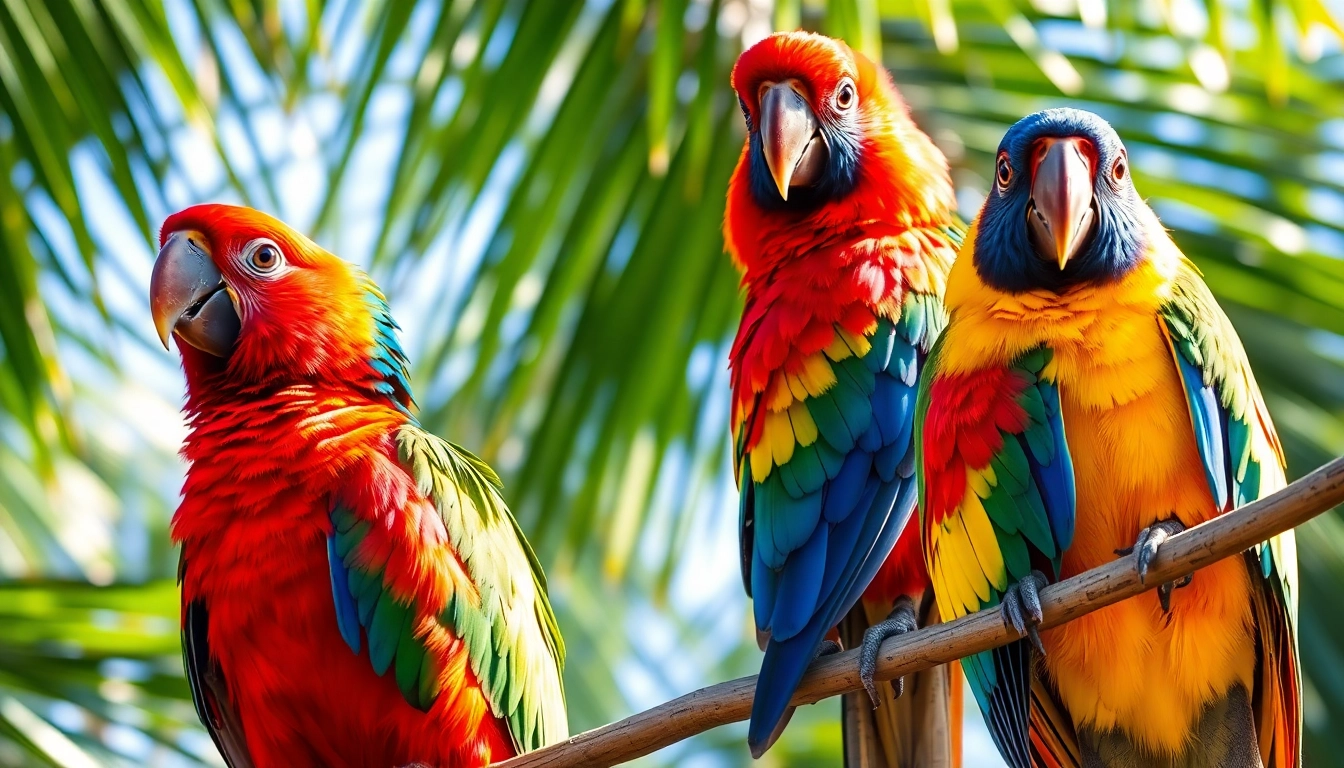Introduction to Parrots: Characteristics and Classification
Parrots, renowned for their vibrant plumage and remarkable intelligence, are among the most captivating and diverse groups of birds worldwide. Belonging to the order Psittaciformes, these birds are characterized by their strong, curved beaks, upright stance, and clawed feet that facilitate grasping and manipulation. With approximately 410 species across 101 genera, parrots occupy a wide range of habitats predominantly in tropical and subtropical regions, making them a global symbol of exotic avian life. Their striking appearance and social behavior have endeared them to bird enthusiasts, researchers, and conservationists alike.
Understanding the key traits that define parrots helps clarify why they are so unique. These traits include highly adaptable beak structures specialized for cracking nuts and seed shells, zygodactyl feet (two toes pointing forward and two backward) that aid in climbing and gripping, and a vocal versatility that allows many species to mimic sounds and even human speech. Their keen intelligence is further evidenced by their problem-solving skills and complex social structures, which are integral to their survival strategies both in the wild and captivity.
Taxonomically, parrots are classified into four main families: Psittacidae (true parrots), Cacatuidae (cockatoos), Psittaculidae (Old World parrots), and Strigopidae (kakapos and kea). Each family encompasses distinctive species with unique behaviors, ecological niches, and care requirements, emphasizing the importance of tailored approaches whether in the wild or in captivity. The diversity within this group is staggering, representing a wide spectrum of sizes—from the small lovebirds to the towering Hyacinth macaw—and habitats spanning dense rainforests to arid scrublands.
Natural habitats of parrots are primarily concentrated in regions such as Central and South America, Africa, Asia, and Australasia. They flourish in dense forests, savannas, and coastal areas, where they often form large flocks that provide safety in numbers. Their geographic distribution reflects a fascinating evolutionary history of adaptation to varied environments, from the lush Amazon basin to the rocky oligarchic islands inhabited by kakapos.
To delve deeper into parrots’ fascinating world, exploring their taxonomy, physical traits, and ecological roles provides essential context for appreciating their importance and the challenges they face today.
Popular Parrot Species: Traits and Care Needs
Overview of Common Pet Parrot Breeds
Among the plethora of parrot species kept as pets, several stand out due to their personality, ease of care, and intelligence. The parrots most frequently encountered in homes include African grey parrots, Amazons, Cockatoos, Lovebirds, and Conures. Each of these breeds exhibits distinct characteristics:
- African Grey Parrots: Celebrated for their exceptional cognitive abilities and linguistic talents, these medium-sized parrots are highly social and thrive on mental stimulation. They require a balanced diet of high-quality pellets, fruits, and vegetables, along with enrichment activities to prevent boredom.
- Amazons: Known for their vibrant plumage and charismatic personalities, Amazon parrots are highly trainable and affectionate, making them popular among experienced bird owners. Their diet includes nuts, seeds, and fresh produce, and they benefit from plenty of interactive playtime.
- Cockatoos: Distinguished by their prominent crests and playful nature, cockatoos need ample attention and mental engagement. Due to their size and dexterity, they require spacious cages and specialized diets rich in calcium and Vitamin A.
- Lovebirds: Small but lively, lovebirds are renowned for their strong pair bonds. They are ideal for smaller living spaces and are relatively easier to care for with proper diet and social interaction.
- Conures: Conures are energetic and affectionate, often displaying a curious disposition. Their diet involves fruits, vegetables, and fortified pellets, combined with social training to foster good behavior.
Wild Parrot Species Found in North America and Beyond
Although many associate parrots with tropical ecosystems, multiple species inhabit North America in the wild. Notably, the Monk parakeet (also known as the Quaker parrot) has established feral populations across urban and suburban areas in the United States, particularly in southern cities like Miami and Los Angeles. These adaptable birds demonstrate remarkable resilience and resourcefulness, thriving in urban environments by nesting in trees or man-made structures.
Apart from North America, wild populations of parrots span continents—ranging from the vibrant Rainbow Lorikeets in Australia to the majestic Hyacinth Macaws in Brazil. In some regions, parrots serve critical ecological roles, such as seed dispersers, maintaining forest health, and fostering biodiversity. Recognizing these diverse species’ needs and behaviors underpins responsible conservation and captivity practices.
Distinct Behaviors and Lifespan Expectations
Behaviorally, parrots are social birds exhibiting a spectrum of intriguing traits, from their playful antics to their strong vocalizations. Many species display complex communication, problem-solving abilities, and, in some cases, the capacity for mimicry—an adaptation that likely evolved for social bonding within large flocks.
Lifespan varies significantly across species, with some like cockatoos and kakapos living up to 60 years or more, while smaller parrots like lovebirds generally live around 10-15 years. Proper diet, mental stimulation, and healthcare directly influence lifespan and quality of life, whether in captivity or the wild. For example, Hyacinth macaws tend to reach around 50 years with attentive care, emphasizing long-term commitment from owners and conservationists.
How to Care for Parrots: Tips and Best Practices
Dietary Requirements and Feeding Techniques
Providing a balanced diet is critical to maintaining parrots’ health and vitality. Their diet should be diverse, mimicking their natural intake of fruits, vegetables, nuts, seeds, and grains. High-quality commercial pellets formulated for parrots supply essential nutrients, while supplementary fresh foods diversify intake and prevent nutritional deficiencies.
Favorites include leafy greens (kale, spinach), bell peppers, carrots, and berries. Avoid processed or toxic foods such as chocolate, avocado, caffeine, and alcohol. Feeding techniques involve offering food in varied forms—shredded, chopped, or whole—and encouraging foraging behaviors to stimulate mental activity.
Habitat Setup and Enrichment Strategies
A well-designed habitat enhances parrots’ physical and psychological well-being. Cages should be spacious, with bar spacing appropriate to the species’ size—generally larger for bigger birds like macaws. Incorporate perches of different diameters, swings, toys, and foraging puzzles to simulate natural behaviors and reduce boredom.
Enrichment also includes supervised outdoor flights or walks in secure environments. Regular changes in cage layout, introduction of new toys, and social interaction with humans or other parrots support their mental health and prevent behavioral issues such as feather plucking or aggression.
Training, Bonding, and Health Maintenance
Successful parrot care hinges on establishing trust and communication. Positive reinforcement training can teach recall, trick behavior, and prevent biting. Building a strong bond involves spending quality time daily, speaking softly, and respecting their social cues.
Health maintenance encompasses routine veterinary check-ups, wing trims, beak and nail care, and monitoring for signs of illness—such as lethargy, feather loss, or abnormal droppings. Preventive measures include parasite control, proper hygiene, and ensuring a toxin-free environment.
Conservation Status and Threats Facing Parrots
Impact of Habitat Loss and Illegal Pet Trade
Across the globe, wild parrot populations face significant threats primarily from habitat destruction, driven by deforestation, agricultural expansion, and urbanization. The loss of nesting sites and food sources diminishes their reproductive success and survival odds.
The illegal pet trade exacerbates these challenges, with thousands of parrots harvested annually and exported from their native habitats. This unsustainable practice not only reduces wild populations but often involves poor handling, transport conditions, and neglect, leading to high mortality rates and genetic bottlenecks.
Global Efforts for Parrot Protection and Rehabilitation
Efforts to conserve parrots include establishing protected areas, enforcing wildlife trade regulations under treaties like CITES, and supporting breeding and rescue programs. Notable organizations such as the World Parrot Trust work tirelessly to monitor populations, rehabilitate confiscated birds, and promote captive breeding as an alternative to wild collection.
Educational campaigns aim to raise awareness among local communities and potential pet owners about responsible sourcing, habitat preservation, and the ecological significance of parrots.
How Enthusiasts Can Contribute to Conservation
Individual actions significantly impact conservation outcomes. Responsible pet ownership entails adopting parrots from reputable breeders, avoiding wild-caught specimens, and providing enriched environments that promote their natural behaviors. Supporting conservation organizations through donations, volunteering, or spreading awareness amplifies efforts to protect wild populations.
Participating in local habitat restoration initiatives and advocating for stronger wildlife protection laws further bolster global efforts to ensure parrots’ survival for generations to come.
Learning More About Parrots: Resources and Communities
Educational Websites and Species Guides
Various online platforms offer extensive information on parrots, including species profiles, care guides, and conservation updates. Trusted resources include the Wikipedia entry on parrots, Britannica’s detailed articles, and specialized organizations like the BirdLife International website. These sources facilitate informed decision-making for enthusiasts and researchers alike.
Volunteer and Rescue Organizations
Numerous rescue centers and nonprofit groups focus on parrot rehabilitation and rehoming. Examples include the World Parrot Trust and local wildlife sanctuaries, which provide volunteering opportunities and foster community engagement. Supporting these organizations helps reduce overcrowding in captivity and promotes the welfare of displaced parrots.
Online Communities and Expert Advice
Engaging with online communities such as Reddit’s r/parrots and dedicated forums enables hobbyists and professionals to exchange advice, share success stories, and troubleshoot challenges. These platforms foster a sense of shared purpose and continuous learning, vital for advancing parrot welfare and conservation efforts.


